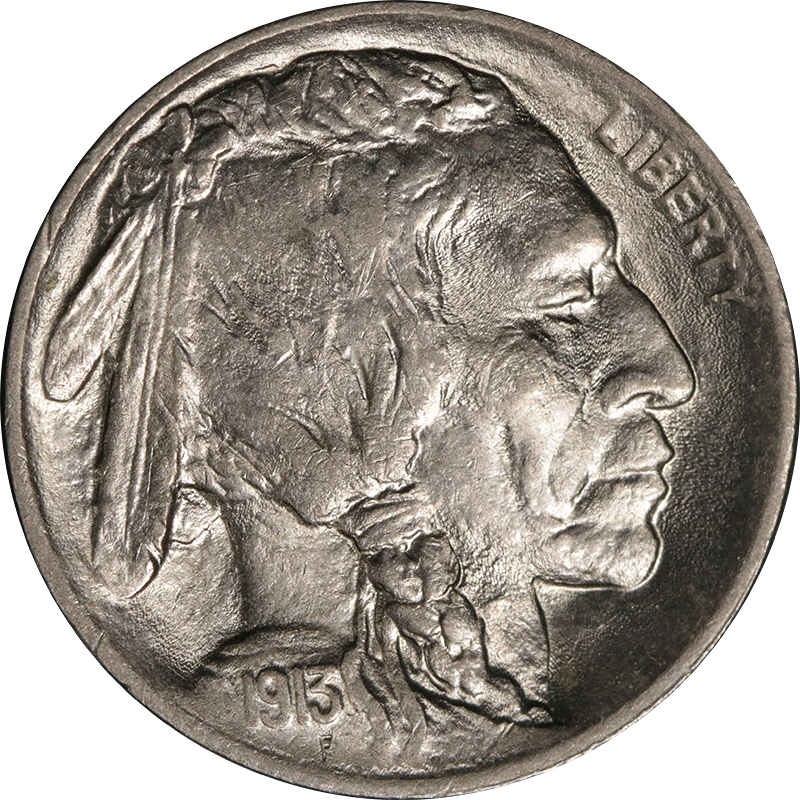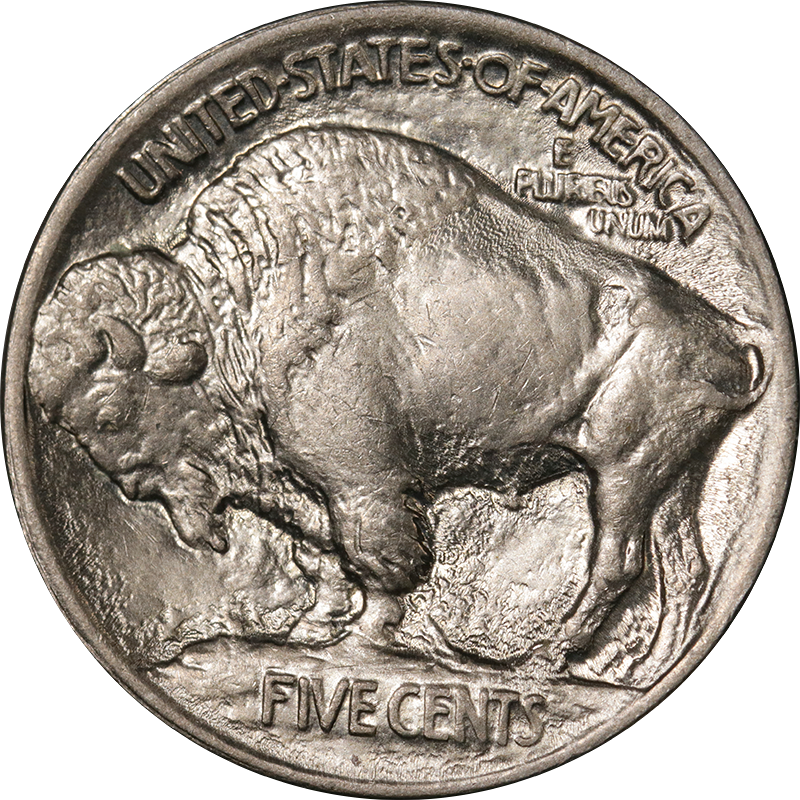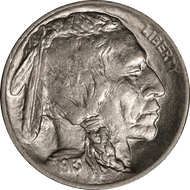Keys to Collecting the Buffalo Nickel and Other Nickels
Jun 2nd 2020
Collecting the Buffalo Nickel


The five-cent coin was born in the aftermath of the Civil War when copper, silver and gold coinage had been hoarded. After the war there was growing need for circulating coinage not made of a metal that would be hoarded, and nickel fit that bill. But these coins were not called nickels because three-cent pieces made of nickel already existed.
The first five-cent coins featured a shield design on their obverse paired with a reverse with the denomination surrounded first by rays from 1866-1867 and then by stars from 1867 to 1883 were actually composed on 75% copper and 25% nickel. That has remained their composition through today’s Jefferson nickels apart from 1942-1945 when the coin was made partly from silver.
In 1883 Shield nickels were replaced by a design known as the Liberty Head nickel that featured a left-facing profile of Liberty surrounded by stars on its obverse and the roman numeral “V” for five on the reverse. Those coins, which were designed by Charles Barber, were issued until 1913. Because the coin was initially issued without the words “cents” some charlatans plated them with gold and tried to pass them as $5 gold coins. The words “cents” were added below the numeral later in the year, and both coins are needed by type collectors.
Buffalo Nickel
An 1890 law (still in effect) only allowed a coin’s design to be changed 25 years after it was first adopted. Beginning in 1907 five U.S. coin denominations had been changed as part of what is known as the renaissance of American coinage. There was considerable support at the time for a new nickel design, and in 1911 the Taft administration commissioned artist and sculptor James Earle Fraser to create a new design. Fraser believed that American coinage had to be distinctly American rather than borrowing motifs from European or other coins and was fascinated with Native American culture because of his childhood when he spent time in the American West.
Who is on the nickel?
The design selected, known as the Buffalo or Indian Head, was an early hit with collectors though it also had its critics when first introduced. It was used from 1913 until 1938. It features on its obverse a right-facing portrait of a Native American chief that is often said to be a composite of three different real chiefs, though their identities remain unclear as Fraser told many different stories about them and various chiefs have come forward saying they were the model. The reverse depicts an American bison or buffalo believed to be based on Black Diamond, a bison that resided at the time at the New York Zoo.
This Buffalo design, which is also called Indian Head, was the first American coin to feature an animal other than an eagle. It has emerged since it was first issued as one of the most iconic and beloved coinage motifs still used today on American Buffalo Gold coins issued since 2006 and which also appeared in 2001 on a popular silver dollar.
The 1913 Buffalo nickel comes in two types due to problems with the first version where the bison rests on a raised mound with the denomination indicated below. This raised positioning left the words “five cents” very vulnerable to wear, so a second version was minted later that year in which the denomination appears in a recessed and flat area under a line at the bottom of the reverse. All type collectors need an example of both versions.
Buffalo Nickel Values
Buffalo nickels are coins that can be collected at any level. Circulated examples of many issues can be obtained for a few dollars or less, but high-quality uncirculated examples for some dates run into the tens of thousands of dollars and more. A complete date and mint ark set without varieties runs about $8,000 in almost uncirculated condition but reaches over $250,000 in MS65. With varieties $8,000 is only enough for a set in good, while an MS60 set runs about $132,000.
Buffalo nickels had major striking problems, making it important to look for examples that are as well struck as you can afford. This is because the design is sculpted in high relief, and there are many intricate details on a small canvas. For all the details to appear on the coin, the metal had to flow to all portions of the dies, and the dies had to be spaced at precise distances. In many cases this did not happen, resulting in poor strikes.
1936 and 1937 Buffalo nickels
1936 Buffalo nickels are significant because this was the first year any U.S. nickel was minted in a quantity exceeding 100 million. 118,997,000 of the 1936 coins were issued, and they can be obtained in MS65 for under $100. For the discerning collector, here is an MS67+ example very close to the finest available, while an MS68 runs about ten times the price of that coin.
In addition, the 1936-S coin is an excellent one for a type set as it was the first of the series which can be found struck with FD (full details) and rich luster.
Rare Buffalo Nickels
1937 Buffalo nickels are easy to obtain with good eye appeal, but are most well-known because of the 1937-D Three legged coin, a very rare coin that was created when a Denver Mint employee used a tool to remove a defect on a reverse, resulting in the right foreleg of the bison being removed. Examples in good are worth $550, while in MS65 it reaches $30,000 and $120,000 in MS67. It is advisable to purchase graded examples of this coin as there are fakes created by grinding down the right foreleg.
The 1935 double die reverse is another rare Buffalo nickel but mainly in high grades. In circulated grades it can be obtained for $100 or less, while an MS65 set a record for the issue when it sold for $104,650 at auction in 2007.
The Buffalo nickels struck at the San Francisco Mint are in most cases the most valuable because fewer were made there than at the Philadelphia and Denver Mints. Some key dates include 1924-S with only 1,437,000 made and 1926-S with just 970,000 made. The latter coin used to be undervalued, but its’ value, especially in mint state, has risen considerably in recent years. 1918-S, 1919-S and 1927-S nickels are also among the most valuable.
There are many condition rarities in the series like the 1938-D, which can be obtained for under $100 in MS65, but reaches almost $800 in MS67+ and several thousand or more in MS68.
Jefferson Nickels
In 1938 the U.S. Mint held a competition to design on a new nickel that would honor our second president. Then President Franklin D. Roosevelt was an admirer of President Thomas Jefferson. The winning design was by German-born sculptor Felix Schlag, who created a left-facing portrait of Jefferson for the obverse, and a front view of Monticello for the reverse.
1940 and 1941 nickels
By 1940 the Great Depression was over, which increased the need for circulating coinage. So production of Jefferson nickels was ramped up at the Philadelphia Mint that year to 176,485,000, which is both almost twice that of the 1939 coin and the highest mintage of the series to that point.
1941 was the last year nickels were minted in the usual 75% copper/25% nickel format before nickel became a strategic metal needed for the war effort, so the composition was changed from 1942 to 1945 to 35% silver, 56% copper and 9% manganese. Coins were issued at the Philadelphia, Denver and San Francisco Mints with large mint marks above the Monticello image on the reverse, including for the first time the “P” coins, which normally have no mint marks.
1964 nickels
In 1964 Mint Director Eva Adams, concerned about coin shortages and believing this was caused by collector hoarding, decided that from 1965 to 1967 nickels would be struck with no mint marks, which they were for those years. 1964-D nickels were issued and are the highest mintage coin for the series. But some people mistakenly believe they are valuable. However, finding well struck examples of this coin is not always easy, and since the dies used during this period did not have the sixth step on Monticello, the best one can find is a coin with five steps.
Nickels since 2004
The Jefferson nickel designs remained unchanged until 2004 when a set of special nickels was issued to honor the bicentennial of the famous Louis and Clark expedition in 1804, including the 2004 Peace medal and Keelboat reverse coins and the 2005 Bison and Ocean in View reverse coins. The later also featured right-facing side portraits of Jefferson by Joe Fitzgerald only used for those two coins.
In 2006 the obverse design was replaced by a more detailed and lifelike front-facing portrait of Jefferson known as “Jefferson 1800” because it is based on a painting of the president from 1800 by artist Rembrandt Peele. That design will be used indefinitely without new legislation and has already appeared on billions of nickels. It was designed by former Artistic Infusion Artist Jamie Franki, who teaches art at the University of North Carolina at Charlotte, and who also created the 2005 Bison reverse design. Jamie said that because everyone receives those coins in change, he was treated almost like a rock star when the coins first came out and that from his experience he learned that “coins really matter for many reasons to many people.”


